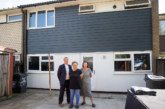
Increasing numbers of climate emergencies have been declared in recent years, further increasing attention upon the need to mitigate the environmental impact of development. Whilst COP26 has renewed public support for measures to curb the climate crisis, legislation and planning policies, which underpin such measures have been evolving since the early 2000s.
James Cook, Head of Planning at Blacks Solicitors, discusses the legislative and planning policy background and how recent changes are going to affect development in the coming years.
UK climate change targets
Although The Climate Change Act 2008 originally committed the UK to a target of an 80% reduction of greenhouse gas emissions by 2050 compared to 1990 levels, in 2019 the target was amended to reduce the UK’s greenhouse gas emissions to “net zero” by 2050 with interim targets set through five-yearly carbon budgets.
In October 2021 the Government published its “Net Zero Strategy: Build Back Greener” ahead of COP26, to outline how the UK will achieve net zero by 2050.
Planning and climate change
Planning authorities are under a statutory duty to ensure that, when taken as a whole, their local development plan documents include policies designed to ensure that the development and use of land contributes to the mitigation of, and adaptation to, climate change.
The National Planning Policy Framework (NPPF) also underlines the importance of mitigating and adapting to climate change as a function of sustainable development, emphasising that the planning system should help to shape places in ways that contribute to radical reductions in greenhouse gas emissions. Local plans should take a proactive approach to mitigating and adapting to climate change, including providing a positive strategy to increase the use and supply of renewable and low carbon energy and heat. Additionally, new developments should be built in ways that both reduce vulnerability to the impacts of climate change and help reduce greenhouse gas emissions.
Avoiding and mitigating flood risk
Sustainable Urban Drainage Systems (SUDS) are designed to imitate natural drainage to reduce surface water flooding and promote water harvesting. In flood risk areas, developments may also be designed in a way to build resilience to future risks, including those arising from climate change (for example through raising finished floor levels and building in flood defences).
Biodiversity Net Gain
Although biodiversity net gain (BNG) is already a feature of national and local planning policy, the recently enacted Environment Act 2021 will require all developments to deliver a BNG as a condition of planning permissions granted in England once in effect. BNG may be delivered on or off site or via the purchase of “biodiversity credits” to mitigate any shortfall.
The importance of BNG to planning will therefore only increase with the advent of the Environment Act 2021. We are likely to see more and more multifaceted and innovative approaches to achieving BNG through habitat creation and enhancement solutions, which offer a combined contribution towards other objectives of sustainable development, including the mitigation of the effects of climate change.
Renewable energy and energy efficiency
The Planning and Energy Act 2008 allows planning authorities in England to require a reasonable proportion of energy used in a development to come from renewable and low carbon sources. Increasing in-built renewable energy measures such as solar panels can reduce the volume of electricity from unsustainable sources used in a development, and when combined with passive measures like enhanced energy efficiency, can significantly reduce environmental impacts.
In December 2021 the Government announced amendments to Building Regulations which aim to reduce carbon emissions from new build homes by around 30% compared to current standards, a prelude to the Future Homes and Buildings Standards which is planned to deliver net zero ready homes from 2025.
Header image ©Choat/AdobeStock









